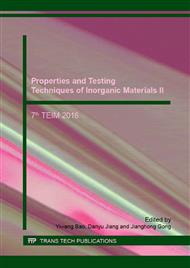p.378
p.383
p.388
p.394
p.399
p.404
p.409
p.414
p.419
Effects of Sintering Temperature on Phases, Microstructures and Properties of Fused Silica Ceramics
Abstract:
Fused silica ceramics, named fused silica articles by means of ceramics fabrication processes, had been widely used in metallurgy, refractory, aviation and many other areas. How to get fused silica ceramics with high density and less cristobalite is on the focus. In this paper, effects of sintering temperature (1150°C, 1200°C, 1250°C, 1300°C, 1350°C) on phases, microstructures and properties of fused silica ceramics were investigated. The results showed that the bulk density of samples increased and the apparent porosity of samples minished gradually, with the increase of sintering temperature. However, the bending strength increased to maximum firstly and then decreased because the emergency of cristobalite at 1300°C. When the sintering temperature was 1250°C, the bulk density, apparent porosity and bending strength was 1.71g·cm-3, 17.6% and 38.87MPa, respectively.
Info:
Periodical:
Pages:
399-403
Citation:
Online since:
January 2017
Authors:
Price:
Сopyright:
© 2017 Trans Tech Publications Ltd. All Rights Reserved
Share:
Citation:


